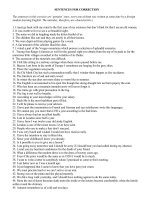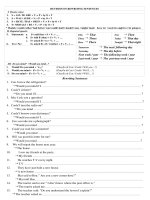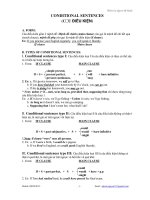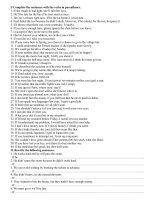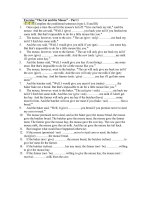cleft sentences
Bạn đang xem bản rút gọn của tài liệu. Xem và tải ngay bản đầy đủ của tài liệu tại đây (315.37 KB, 14 trang )
Ex:The pupils learnt the lesson in the classroom
S V
It was the pupils that/ who learnt the lesson in the classroom.
Be S V
1.Subject focus
The dog grabbed at the bone.
S V
It was the dog which/that grabbed at the bone.
Be S V
It
It
+
+
is/was
is/was
+
+
S
S
+
+
that
that
+V… (chính…. làm gì)
+V… (chính…. làm gì)
I.Cleft sentences in active.
Muốn nhấn mạnh vào chủ thể hay người gây ra hành
động,người ta dùng câu chẻ để diễn đạt và đặt trọng tâm vào
chủ thể đó.Để nhấn mạnh chủ ngữ, ta đưa chủ ngữ đó vào giữa
it is/was và that.
Chúng ta có thể dùng who (chỉ người),which(chỉ vật,sự vật)
thay cho that khi nhấn mạnh chủ ngữ .
Khi chủ từ số nhiều được nhấn mạnh, thì động từ trong
mệnh đề quan hệ ở số nhiều
It
It
+
+
is/was
is/was
+
+
S
S
+
+
that
that
/
/
who
who
+V…… (chính…. làm gì)
+V…… (chính…. làm gì)
Ex: The man gave her the book
It was the man that gave her the book
Ex2. Tom gave Mary a rose
It was Tom who/that gave Mary a rose
Ex 3. Daisy washes clothes every day
It is Daisy who/that washes clothes every day
1. The boy visited his uncle last month.
It was the boy who visited his uncle last month.
2. My mother bought me a present on my birthday.
It was my mother who/ that bought me a present on my
birthday.
3. Huong and Sandra sang together at the party.
It was Huong and Sandra that/who sang together at the party
4. Nam's father got angry with him.
It was Nam's father that/who got angry with him.
REWRITE THE SENTENCES, USING CLEFT SENTENCESS
5. The boys played football all day long.
It was the boys who/who played football all day long.
6. The girl received a letter from her friend yesterday
It was the girl that /who received a letter from her friend yesterday
The pupils learnt the lesson in the classroom.
O
It was the lesson that the pupils learnt in the classroom.
O S V
2.OBJECT FOCUS
It+ is/ was+ O+ that/who(m)+ S+ V ………
Để nhấn mạnh vào túc từ hay đối tượng của
hành động, người ta dùng câu chẻ để diễn đạt và
đặt trọng tâm vào túc từ. Ta đưa túc từ vào giữa
It is/ was và that
Khi nhấn mạnh túc từ ta chỉ sử dụng that.
The boy hit the dog in the garden
It was the dog that the boy hit in the garden
4. Hoa borrowed the book from Long.
It was the book that Hoa borrowed from Long.
3. She sent her friend the postcard.
It was the postcard that she sent her friend.
2.The woman gave him the book.
It was the book that the man gave him.
1.The man is learning English.
It is English that the man is learning.
REWRITE THE SENTENCES, USING CLEFT SENTENCESS
5. The little boy greeted his grandfather in a strange language
It was his grandfather who(m) the little boy greeted in a
strange language.
6. The pedestrian asked the policeman a lot of questions
It was the policeman that/whom the pedestrian asked a lot of
questions
3. ADVERBIAL FOCUS
Ex1:The pupils learnt the lesson in the classroom.
adverb of place
It was in the classroom that the pupils learnt the lesson.
adverb of place S V
Ex2: She bought him a shirt at the shop
It was at the shop that she bought him a shirt
It+ is/was+ adverbial focus+ that+ S+ V ……
Muốn nhấn mạnh vào trạng ngữ( thời gian ,địa điểm) của
mệnh đề, người ta dùng câu chẻ để diễn đạt và đặt trọng tâm
vào chu cảnh hay trạng ngữ.
Để nhấn mạnh trạng ngữ ,ta đưa trạng ngữ đó vào giữa It is/
was và that
Khi nhấn mạnh trạng ngữ ta chỉ sử dụng that
1. The boy hit the dog in the garden
It was in the garden that the boy hit the dog
2. She made some cakes for tea
It was for tea that she made some cakes
3. His father repaired the bicycle for him
It was for him that his father repaired the bicycle
5. He met his wife in Britain
It was in Britain that he met his wife.
6. She bought that present from the shop
It was from the shop that she bought that present.
7. The meeting started at 8.00a.m
It was at 8.00a.m that the meeting started
REWRITE THE SENTENCES, USING CLEFT SENTENCESS
Form:
Ex1: The boy saw the dog in the garden.
It was the dog that was seen in the garden by the boy.
It + was/is + O + that + (is/are/am/was/were/ ) + past participle + (by+O)
Ex2: The children broke the window yesterday.
It was the window that was broken by the children yesterday.
2.Cleft sentences in passive.
Ex3:She frightened the children.
It was the children that was frightened by her
Ex4:.Her younger sister broke her glasses.
It was her glasses that was broken by Her younger sister
Ex5:The Prince kissed my younger sister at the party.
It was my younger sister that was kissed at the party by the
Prince
It was this story book that was given me as a birthday present
by My father
Ex6: My father gave me this story book as a birthday present.
1. Fans gave Christina lots of flowers.
2. The pedestrian asked the policeman for direction to the post office
3.People talked a lot about his house.
4. His father bought him a bicycle for his birthday.
5. He described his hometown in his novel.
10.Vietnamese people celebrate Tet as the greatest occasion in a
year.
Change the sentences into cleft sentences in the passive
It was Christina who/that was given lots of flowers
It was his house that was talked a lot about
It was the policeman that was asked for direction to the post office
by the pedestrian.
It was a bicycle that was bought for his birthday by his father
It was his hometown that was described in his novel (by him)
It was Tet that was celebrated as the greatest occasion in a year
by Vietnamese people
Rewrite the following sentences using the structure it is/ was
that + passive voice
1. It was Mr. Johnson that every student respected to.
2. It was in Bristol where they made the film.
3. It was the manager that we saw.
4. It was wine that we ordered.
5. It is the English exam that the students most worry about.
It was Mr John son that was respected to by every student.
It was in BristoI that the film was made.
It was the manager that was seen.
It was wine that was ordered.
It is the English exam that is most worried about by the students.
Rewrite the following sentences using the structure it is/ was that +
passive voice
6. It is pop music that my brother prefers.
7. It is Tet that Vietnameses celebrate, as the greatest occasion in a
year
8. It was the computer that my parents gave me as a birthday
present.
9. It is Santa Clause who most children are waiting for on Christmas
Eve.
10. It is English that people all over the world use.
It is pop music that is prefered by my brother.
It is Tet that is celebrated as the greatest occasion in a year by
Vietnameses.
It was the computer that was given to me as a birthday present by my
parents.
It is Santa Clause that is been waiting for on Christmas Eve by
most children.
It is English that is used by people all over the world.
Choose the word whose underlined part pronounced differently from that of the
others:
1. a. marched b. reached c. watched d. needed
2. a. sits b. meets c. reads d. eats
3. a. kids b. friends c. tickets d. robs
4. a. wanted b. changed c. managed d. bridged
Choose the best answer:
5. Not only my son but also I …………….tired of walking so far.
a. is b. are c. am d. were
6. Endive can be used………as a salad green or as a cooking vegetable.
a. such b. both c. either d. neither
7. Thomas studied not only painting……… anatomy when he was trained to
become an artist.
a. moreover b. but also c. as well d. and
8. It was the musical performance on TV that ………by our family.
a. was enjoying b. was enjoyed c. enjoyed d. was enjoyable
9. They invited ……….to their golden anniversary.
a. my wife and I b. I and my wife c. both my wife and me d. All are correct
10. It is English…is spoken in many parts of the world.
a. when b. that c. whose d. who
Cleft sentences
•
Cleft sentences are used to help us focus on
a particular part of the sentence and to
emphasize what we want to say by
introducing it or building up to it with a kind of
relative clause. Because there are two parts
to the sentence it is called cleft (from the verb
cleave) which means divided into two.
•
Cleft structures include the reason why,
the thing that, the person/people who, the
place where, the day when and what-
clauses which are usually linked to the clause
that we want to focus on with is or was.





